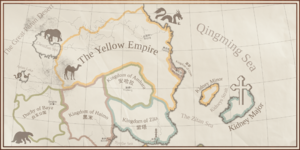Yellow Empire
Jump to navigation
Jump to search
 This Eurth-related article is a stub.
This Eurth-related article is a stub.
Yellow Empire | |
|---|---|
| from $year – to 1500s | |
Coat of arms
| |
| The Yellow Empire at its greatest extent The Yellow Empire at its greatest extent | |
| Capital | $Place |
| Common languages | $language(s) |
| Religion | $religion(s) |
| Government | Absolute monarchy |
| Legislature | $legislature |
| Currency | $currency |
| Today part of | |
(This lore has been abandoned by its creator.)
History
What we know so far about the Yellow Empire comes from a collection of various sources.
From Fulgistan
- Fulgistan was a key province of the Yellow Empire until its fall in the 1500s. The first state dominated by the Fulgistani people after the dissolution of the Yellow Empire emerged in 1655 with the formation of the Sultanate of Fulgistan.
- The area now known as Greater Fulgistan (including the disputed Takhar and Kunduz Conflict Zone) was once part of the Yellow Empire, first conquered by the Toujian Emperor in the 2nd century BCE, Fulgistan would become one of the core provinces of the Yellow Empire, whose rulers drew from it fine horses, cattle, fruits, and fierce warriors. Fulgistan would produce several emperors during its time as an imperial province, including the famed Zhanfang Emperor. During the 10th century CE, traders from Sa Hara began visiting Fulgistan, importing both art and architecture, as well as Salam. When the Yellow Empire suffered its collapse in 1545, Fulgistan generally remained under the sway of the Cao Dynasty during the Snake and Tiger Period from the collapse until the 17th century. In 1655, the Sultanate of Fulgistan was established, marking the first cohesive Fulgi-dominated state in the area. In addition, the Sultanate was the first nation in eastern Alharu to practice Salam as a state religion, in contrast to the folk religion and various regional faiths of the Yellow Empire. However, even after unification under the Sultanate, the population remained decentralized, with most continuing to lead a pastoral, nomadic life.
From Rhava
- Most of early Rhavanese history talks about the many wars between the Rhavanese kingdoms and the Yellow Empire. It's said that one of the reasons the Yellow Empire was not able to take over the country fully was because they were not used to fighting in the thick jungles and mountains, and under the sweltering sun. They nicknamed the area 日国,the sun kingdom.
- The Yellow Empire influenced much of northern Rhava, providing a unique style of Architecture, and bringing to the Rhava the language of Huang, which through the ages became a Rhavanese dialect that is still used and taught in modern day.
- Even after the fall of the Yellow Empire, Rhava still has a similar rocky relationship with the successors of the empire, such as Fulgistan.

